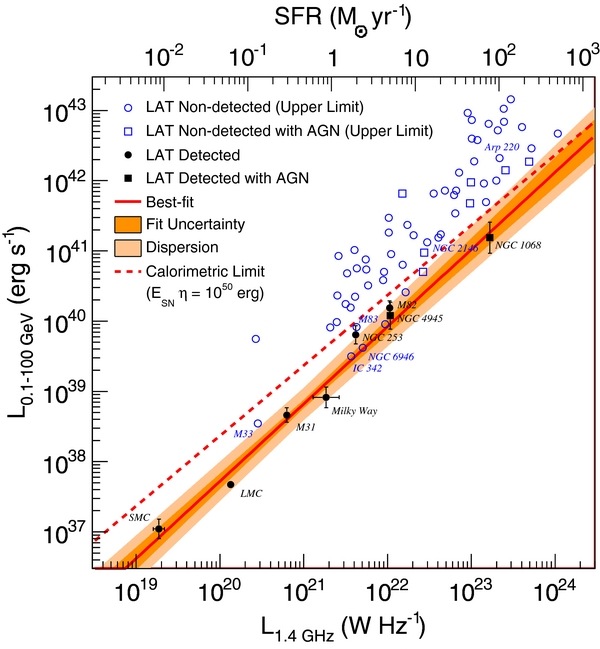Cosmic rays in star-forming galaxies
Our Galaxy is permeated by a fluid of relativistic particles called cosmic rays. These nuclei, electrons, and positrons are most likely energized by violent events such as supernova explosions and pulsar winds. Yet, CRs are not only a side-product of such phenomena, they also contribute to the physical and chemical evolution of the Galaxy. As such, it is crucial to understand how they interact with the different components of the interstellar medium (ISM). This is made possible by different radiation mechanisms such as Bremsstrahlung and synchrotron, which basically trace these interactions. Performing such studies in our Galaxy is complicated by line-of-sight accumulation. Looking outside, towards neighbouring star-forming galaxies may cast a new light on the role of cosmic rays in a galaxy.
Required instrument performances:
The physical modelling of observations of several star-forming galaxies, ranging from radio to GeV and TeV gamma rays, does not unambiguously tell how cosmic-ray transport proceeds. Making the distinction between several scenarios would require an extension of the GeV sensitivity of the Fermi/LAT instrument down to <10 MeV.

Gamma-ray luminosity (0.1–100 GeV) versus radio continuum (RC) luminosity at 1.4 GHz. Galaxies significantly detected by Fermi/LAT are indicated with filled symbols whereas galaxies with gamma-ray flux upper limits (95% confidence level) are marked with open symbols. Galaxies hosting Swift-BAT AGNs are shown with square markers. The upper abscissa indicates SFR estimated from the RC luminosity. The red solid line and associated shaded regions show the best power-law fit to the data and associated uncertainties. The dashed line represents the expected gamma-ray luminosity in the calorimetric limit assuming an average cosmic-ray luminosity per supernova of 1050 erg. Credit: M. Ackermann et al. 2012, ApJ 755, 164 |
The physical modelling of observations of several star-forming galaxies, ranging from radio to GeV and TeV gamma rays, does not unambiguously tell how cosmic-ray transport proceeds. Making the distinction between several scenarios would require an extension of the GeV sensitivity of the Fermi/LAT instrument down to <10 MeV.
| Performance parameter | Goal value | Remarks and notes |
|
Field-of-view (FWHM, deg) |
A few sr | To ensure a large coverage of many objects, but can be only 10-15° if pointed observations. |
|
Angular resolution (FWHM, deg) |
0.1° | To resolve the SMC and LMC |
|
Spectral resolution (ΔE/E @ Energy) |
Not a concern. | |
|
Line sensitivity (@ Energy) (cm-2 s-1, 3σ, 1 Ms) |
Not applicable. | |
|
Continuum sensitivity (in which energy band?) (cm-2 s-1 keV-1, ΔE=E, 3σ, 1 Ms) |
< 4×10-12 @ 100 MeV |
Goal is a flat sensitivity of < 6 × 10-11 erg/cm2/s over 1-100 MeV band, in order to discriminate different transport scenarios. |
| Timing performances | Not applicable. | |
|
Polarimetric capability (Minimum Polarization Fraction for a Crab source in 1 Ms) |
|
Not applicable. |
| Real-time data? | Not applicable. |
 AstroMeV
AstroMeV